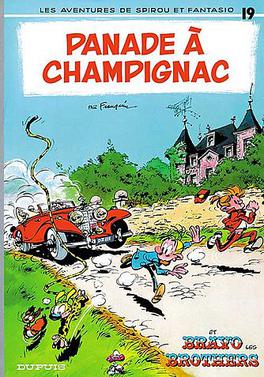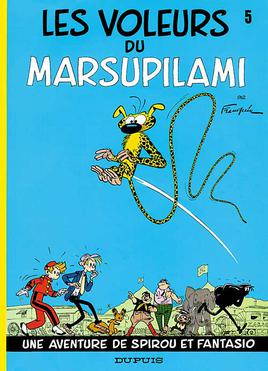
Gaston is a Belgian gag-a-day comic strip created in 1957 by the Belgian cartoonist André Franquin in the Franco-Belgian comics magazine Spirou. The series focuses on the everyday life of Gaston Lagaffe, a lazy and accident-prone office junior who works at Spirou's office in Brussels. Gaston is very popular in large parts of Europe and has been translated into over a dozen languages, but except for a few pages by Fantagraphics in the early 1990s, there was no English translation until Cinebook began publishing English language editions of Gaston books in July, 2017.

Zorglub is a fictional character in the Belgian comic strip Spirou et Fantasio, created by Greg and André Franquin, and first appeared in the serialised story Z comme Zorglub in Spirou magazine in 1959, later published in the diptych albums "Z comme Zorglub" (1961) and "L'ombre du Z" (1962). Zorglub's character was initially that of a sinister megalomaniac, mad scientist, but also a clumsy and bungling one who later reformed and became a friend and ally to the protagonists.

Marsupilami is a comic book character and fictional animal species created by André Franquin. Its first appearance was in the 31 January 1952 issue of the Franco-Belgian comics magazine Spirou. Since then it appeared regularly in the popular Belgian comics series Spirou & Fantasio, as a pet of the main characters, until Franquin stopped working on the series; the character's final appearance in the series during Franquin's lifetime was in 1970.

Spirou & Fantasio, commonly shortened to Spirou, is one of the most popular classic Franco-Belgian comics. The series, which has been running since 1938, shares many characteristics with other European humorous adventure comics like The Adventures of Tintin, Lucky Luke, and Asterix. It has been written and drawn by a succession of artists.

Champignac, or specifically Champignac-en-Cambrousse, is a fictional village frequently featured in the adventures of Spirou et Fantasio by André Franquin and the successive authors. The initial idea of Champignac is attributed to Henri Gillain. The village was introduced in the adventure Il y a un sorcier à Champignac, first published in Spirou magazine in 1950.

Le prisonnier du Bouddha, written by Franquin and Greg, drawn by Franquin with assistance by Jidéhem, is the fourteenth album of the Spirou et Fantasio series. The story was initially serialised in Spirou magazine before its release as a hardcover album in 1960.

Le faiseur d'or, written and drawn by Fournier, is the twentieth album of the Spirou et Fantasio series, and the first to follow the Spirou retirement of André Franquin. The story was initially serialised in Spirou magazine, before publication grouped with Un Noël clandestin and Le champignon nippon in a hardcover album in 1970.

Panade à Champignac is the nineteenth album of the Spirou et Fantasio series. The story, written and drawn by Franquin, was serialised along with Bravo les Brothers in Spirou magazine before publication as a hardcover album in 1969.

L'ombre du Z, written and drawn by Franquin with Greg and Jidéhem, is the sixteenth album of the Spirou et Fantasio series, and the second part of Franquin's Zorglub diptych. The story was initially serialised in Spirou magazine, before its release as a hardcover album in 1962.

Z comme Zorglub, written and drawn by Franquin, is the fifteenth album of the Spirou et Fantasio series, and the first part of Franquin's Zorglub diptych. The story was initially serialised in Spirou magazine before its release as a hardcover album in 1961.

Les pirates du silence, written and drawn by Franquin, is the tenth album of the Spirou et Fantasio series. The title story, and another, La Quick Super, were serialised in Spirou magazine before both were published in one hardcover album in 1958.

Du glucose pour Noémie, written and drawn by Fournier, is the twentyfirst album of the Spirou et Fantasio series, and the author's second, following the Spirou retirement of André Franquin. The story was initially serialised in Spirou magazine before it was published, along with the short story Un faux départ, as a hardcover album in 1971.

Les Chapeaux noirs, album in the Belgian comic series Spirou et Fantasio, released in 1952. The album contains the longer story Les Chapeaux noirs written and drawn by Franquin, and three shorter stories, Mystère à la frontière by Franquin, and Comme une mouche au plafond and Spirou et les hommes-grenouilles by Jijé. All the stories were previously serialised in the Franco-Belgian comics magazine Spirou between 1949-50.

Il y a un sorcier à Champignac, by Franquin, is the second album of the Spirou et Fantasio series, and the first to tell a long intricate story in what would become the Spirou tradition, in contrast to the previous short format stories. After serial publication in Spirou magazine, it was released as a complete hardcover album in 1951.

Les voleurs du Marsupilami, published in English as The Marsupilami Thieves, is the fifth album of the Spirou et Fantasio series, written and drawn by Franquin. The story is a continuation from where the previous album, Spirou et les héritiers, left off. After serial publication in Spirou magazine, the story was released as a complete hardcover album in 1954.

Le dictateur et le champignon, written and drawn by Franquin, is the seventh album of the Spirou et Fantasio series. After serial publication in Spirou magazine, the story was released as a hardcover album in 1956.

Le repaire de la murène, written and drawn by Franquin, is the ninth album of the Spirou et Fantasio series, adding underwater adventure to the Spirou universe. After serial publication in Spirou magazine, it was released as a complete hardcover album in 1957.

Noël, or Le Petit Noël, is the main character of an eponymous Belgian comics series, and a secondary character of Spirou et Fantasio. His name means "Christmas" in French. The series Noël was created in 1957 by André Franquin and Jidéhem and published in the Franco-Belgian comics magazine Spirou, while Franquin created the following work alone or together with Will.
Marcel Denis was a French-speaking Belgian comics creator. He was the creator of the series Hultrasson and Les Frères Clips in Spirou magazine. He also made two episodes of Tif et Tondu. He was a part of the so-called Marcinelle School, influenced by Jijé and André Franquin.


















